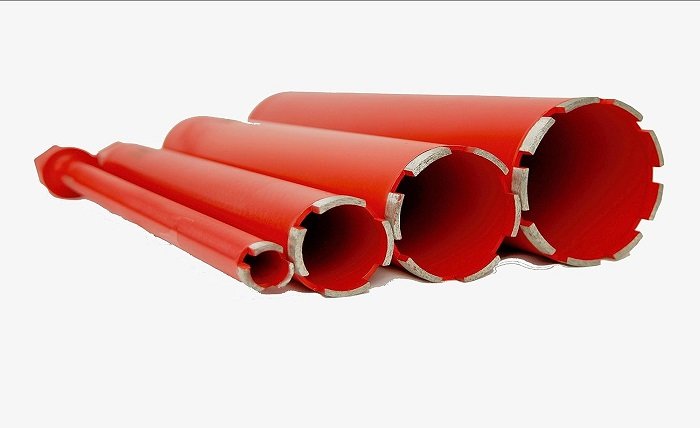Core Bit: What Is It and How to Use It?

If you are working on a project that requires drilling holes in hard materials such as concrete, brick, stone, or masonry, you might need a core bit. A core bit is a special type of drill bit that can cut through these materials and extract a cylindrical piece of material, called a core. In this blog post, we will explain what a core bit is, how it works, what types of core bits are available, and how to use them properly.
What is a Core Bit?
A core bit is a cutting tool that has a hollow center and a circular rim with embedded diamond or carbide segments. The diamond or carbide segments are the cutting edges that grind through the material and create the hole. The hollow center allows the core bit to collect the drilled-out material and leave a clean hole. The core bit is attached to a drill or a coring machine that provides the power and rotation.
Core bits are different from hole saws, which are also used to create large holes in various materials. Hole saws are meant to cut through the entire thickness of the material and discard the waste, while core bits are designed to cut only a portion of the material and remove a core sample or to drill a hole without leaving any waste.
Read more about: pixbet
What Types of Core Bits are Available?
There are many types of core bits available in the market, depending on the size, shape, material, connection end, and application. Some of the common types are:
- Diamond Core Bits: These are the most popular type of core bits for drilling in concrete and other hard materials. Diamond core bits have diamond powder embedded into their surface for extra grinding power. Diamond core bits can be wet or dry, depending on whether they require water cooling or not. Wet diamond core bits are more durable and can drill faster and deeper than dry diamond core bits, but they also require a water source and a pump. Dry diamond core bits can be used without water, but they generate more dust and heat and have a shorter lifespan.
- Carbide Core Bits: These are another type of core bits for drilling in masonry and other softer materials. Carbide core bits have carbide tips or inserts that cut through the material with less friction and wear. Carbide core bits can also be wet or dry, depending on their design and application.
- Engineering Core Bits: These are special types of core bits for drilling in specific materials or applications that require high precision and performance. Engineering core bits can have different shapes, sizes, and features to suit the requirements of the project. For example, some engineering core bits have centering bits or pilot drills to guide the drilling process and prevent wandering. Some engineering core bits have speed modules or turbo segments to increase the drilling speed and smoothness.
- Specialty Core Bits: These are custom-made types of core bits for drilling in unusual or challenging materials or applications that require unique solutions. Specialty core bits can have different configurations, coatings, or attachments to enhance their functionality and efficiency. For example, some specialty core bits have vacuum brazed segments or electroplated diamonds to increase their durability and resistance to abrasion. Some specialty core bits have extensions or adapters to fit different machines or connections.
Read more about: overwatch patch notes
How to Use Core Bits?
Using core bits requires some preparation, skill, and safety precautions. Here are some steps you can follow to use core bits properly:
- Choose the right type of core bit for your material and application. Consider the diameter, length, segment type, connection end, and drilling mode of the core bit. You can consult the manufacturer’s specifications or recommendations for guidance.
- Choose the right type of drill or coring machine for your core bit. Make sure the machine has enough power, speed, torque, and stability to handle the core bit. You can also consult the manufacturer’s specifications or recommendations for guidance.
- Attach the core bit to the drill or coring machine securely and correctly. Make sure the connection end matches the machine’s spindle or chuck. Tighten the screws or nuts if needed.
- Mark the center of the hole you want to drill on the material. Use a pencil, chalk, tape, or any other marking tool.
- Align the core bit with the marked center of the hole. If your core bit has a centering bit or pilot drill, use it to start drilling a small hole to guide the rest of the drilling process. If your core bit does not have a centering bit or pilot drill, use a hammer drill with a regular drill bit to make a small hole first.
- Start drilling slowly and steadily with moderate pressure. Do not force or push too hard on the core bit as this can cause overheating, jamming, or breaking. Let the core bit do its work at its own pace.
- If you are using a wet core bit, make sure you have enough water supply and flow to cool down the core bit and flush out the dust and debris. You can use a water hose, a water tank, or a water pump to provide the water. Adjust the water flow according to the drilling speed and depth.
- If you are using a dry core bit, make sure you have enough ventilation and dust extraction to prevent overheating and breathing problems. You can use a fan, a vacuum, or a dust collector to remove the dust and debris. Wear a respirator, goggles, gloves, and ear protection to protect yourself from the dust and noise.
- Drill until you reach the desired depth or until the core bit breaks through the material. You can use a depth gauge, a tape measure, or a mark on the core bit to measure the depth. If you need to drill deeper than the length of the core bit, you can use an extension or another core bit to continue drilling.
- Stop drilling and turn off the machine. Remove the core bit from the hole carefully and gently. Do not twist or pull too hard on the core bit as this can damage the core or the material. Use a pry bar, a hammer, or a pliers to loosen and extract the core from the core bit.
- Clean and inspect the core bit after each use. Remove any dust, debris, or residue from the core bit with a brush, a cloth, or compressed air. Check for any cracks, chips, or wear on the core bit segments. Sharpen or replace the core bit if needed.
Conclusion
A core bit is a cutting tool that can drill holes in hard materials and extract a cylindrical piece of material. Core bits have different types, sizes, shapes, and features to suit different materials and applications. Using core bits requires choosing the right type of core bit and drill or coring machine, attaching the core bit securely and correctly, aligning the core bit with the center of the hole, drilling slowly and steadily with moderate pressure, cooling or ventilating the core bit adequately, stopping and removing the core bit carefully and gently, and cleaning and inspecting the core bit after each use. By following these steps, you can use core bits effectively and safely for your projects.



